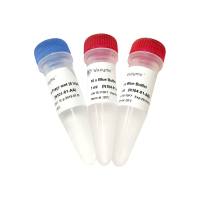Radiolabeling of DNA with the Klenow Fragment of DNA Polymerase
互联网
574
The Klenow fragment of DNA polymerase I is a proteolytic fragment obtained by the treatment of DNA polymerase I with subtilisin. The fragment still has the polymerase and 3′–5′ exonuclease activity, but lacks the 5′–3′ exonuclease activity of the holoenzyme ( 1 ). Radiolabeling of DNA fragments is most efficient with DNA fragments that contain recessed 3′ ends ( see Fig. 1 , Chapter 39 ). The method described here is for generating 3′ end-labeled DNA fragments that are suited for sequencing by the method of Maxam and Gilbert (Chapter 51 ), but can in principle also be used when radioactively labeled DNA is required for other purposes (e.g., Southern hybridization). The principle of the method is shown in Fig. 1 . The DNA fragment to be labeled is incubated in the presence of one or more deoxyribonucleotide triphosphates (one of which is labeled with 32 P in the a-phosphate group) and the Klenow fragment of DNA polymerase. As in the case with the kinase labeling of DNA (Chapter 39 ), the DNA fragment is cleaved with a second restriction enzyme, to generate fragments of unequal size that are labeled only in one end.The fragments are subsequently separated on the basis of their different molecular weights and isolated (chapter 7 and chapter 10 ).
Fig. 1. Labeling of DNA with Klenow polymerase.









